THE Societa Italiana Auto-Trasforrnazioni-Accessori was founded in 1926, manufacturing go-faster equipment for popular Italian cars in its works in Turin. There was always a close link with Fiat, and the new Fiat Tipo 508S Ballila Spyder Sports which ran in the 1933 Mille Miglia had Siata ohv cylinder heads and Siata four-speed gearboxes, but these enhancements were not enough to prevent the cars from being thrashed by the more powerful (and more expensive) MG Magnettes.
The ohv conversion pushed the Ballila's power output from around 30 bhp to 36 bhp: in 1934 Siata announced a supercharger for this car which raised the engine's potential to 55 bhp. They built a blown single-seat Ballila which could achieve around 95 mph: and when the diminutive 500cc Fiat Topolino appeared, Siata turned their attention to the unrewarding task of turning it into a competition car.
Renato Donati
In the touring class of the 1937
Mille Miglia, a Topolino with Siata ohv conversion driven by Spotorno and Besana covered 1615 km of the course at an average speed of just under 50mph. In the 1938
Mille Miglia, an open two-seater Topolino-Siata (quite a good- looking little car with faired pontoon wings and inset headlamps) was converted into an odd-looking coupe with the addition of a streamlined hardtop by the flying ace Renato Donati: another strange feature was a third headlamp mounted cyclops fashion above the radiator grille.
In its most developed form, an aerodynamic coupe with full-width bodywork and enclosed rear wheels, the Siata version of the Topolino had an engine increased in capacity to 596cc, developing 30bhp at 5500rpm; maximum speed was around 75mph. And in 1938 one of these coupes set a 24 hour class record, averaging 70mph throughout the run; a full-width open-two-seater with a long tail was also available, and known as the Pescara.
The Siata Bersaglieri
After the war, Siata announced an intriguing little sports car called the Bersaglieri, which had a light-alloy four-cylinder twin overhead camshaft engine displacing a mere 750cc mounted at the rear of a tubular chassis independently suspended all round on coil springs. The light-alloy body had an exposed, aircraft-type radiator, and seated three with the driver in the centre. A very advanced self-locking differential was another feature of this unorthodox model.
The Siata Amica
Alongside it was offered a Siata cast in a more orthodox mould, known as the Amica, and available in 500cc and 750cc form. Once again, the power unit was the Fiat 500 engine but with extensive modifications. Though the 500cc version retained the standard Fiat two-bearing crank, the bored-out 750cc Amica had a special Siata fully balanced crankshaft with three main bearings; also fitted were oversize valves with multiple springs and a specially-profiled camshaft, again of Siata's own make. Claimed output of the 500cc version was 22bhp at 4400rpm, and of the 750cc 25bhp at 4500rpm, a surprisingly small improvement in view of all the modifications.
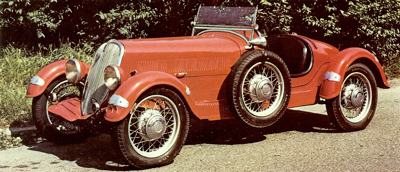 A 1934 Fiat 508S Ballila Spyder Sport, which was fitted with a Siata supercharger.
A 1934 Fiat 508S Ballila Spyder Sport, which was fitted with a Siata supercharger.
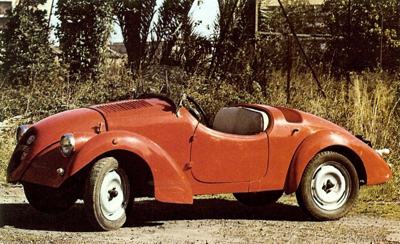 1937 Siata Gran Sport 750, derived from the 1937 Fiat 500.
1937 Siata Gran Sport 750, derived from the 1937 Fiat 500.
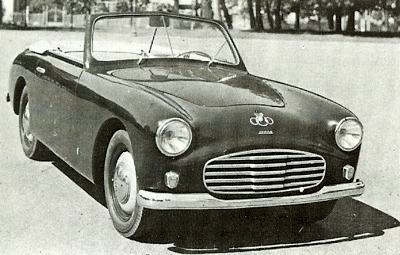 1949 Siata Amica.
1949 Siata Amica.
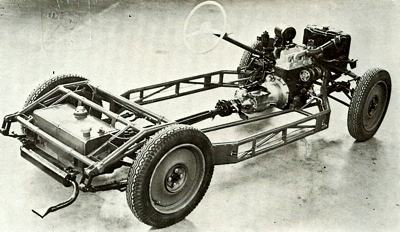 1949 Siata Amica Chassis.
1949 Siata Amica Chassis.
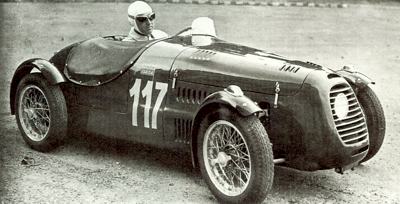 1948 Siata Fiat TC Competition, based on Fiat mechanicals but highly modified.
1948 Siata Fiat TC Competition, based on Fiat mechanicals but highly modified.
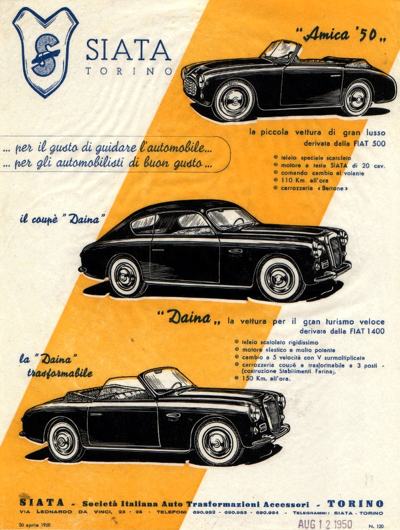 |
The Amica had a tubular chassis with independent front suspension by transverse leaf spring and wishbones, though the standard Fiat rear axle with semi-elliptic springs was retained. Standard wear for the Amica was a two-seater sports body, though a sporting coupe was also available, and a four-speed gearbox was fitted, though a five-speed transmission was used on the special 42 bhp Amica 750 which won the Italian championship in 1948 with a speed of 95mph. In normal trim the 500cc Amica could achieve 62 mph, and the 750 71 mph.
The Siata Daina
Another model, the Daina, appeared the following year. This used the Fiat 1400 as a basis, in conjunction with a sheet-steel box section chassis, and had a claimed top speed of over 90 mph, thanks to several modifications which boosted the engine power output from 44bhp to 65bhp; included among these were a twin-carburetter manifold and an increase in the compression ratio. Another Fiat 1400-based model, the Rallye tourer, was announced in 1951: this was a blatant attempt to cream off some of the success of the MG sports car line, and was a close stylistic copy of the MG TD, even down to the radiator and separate headlamps, though a five-speed gearbox was something that Abingdon did not offer.
The Tipo America Roadster 208S
It was around this time that Fiat themselves decided to get in on the high-performance, limited-production formula, and Siata were called in to help with the development of a new 1996cc V8 model, which was launched at the 1952 Geneva Show. All-round independent suspension by coil-springs was a feature of the Fiat V8, and Siata used this chassis as a basis for some handsome sporting coupes with five-speed transmissions and Vignale or Bertone coachwork; typical was the Tipo America roadster 208S, which looked like an AC Cobra.
Alternatively, there was a 208S Spyder, a stark open two-seater with flared wings and external exhaust, which scaled only 17tcwt. Top speed of the Siata 208S coupe was said to be over 125 mph, though the Spyder's bluff snout slowed the maximum of this model somewhat.
The Siata Mitzi
Totally different in concept was the 1953 Siata Mitzi, a tiny mini-car essayed in 1953-54. Purely utilitarian in appearance, the Mitzi had a rear-mounted twin-cylinder power unit of only 328cc, which developed a puny 12.2 bhp, sufficient to propel the little two-seater coupe along at speeds far lower than usually associated with Siata products.
One unusual feature of the design, however, was all-round independent suspension by torsion bars. Another venture during the 1950s was the fitting of US power units into Siata chassis; engines as diverse as the 720cc Crosley and V8 Chrysler appeared in Siata guise, as well as the more common Fiat 600 and 1100 motors.
Siata and Abarth
During 1960 there was a link-up between Siata and Abarth, though both companies continued to operate as separate entities. By 1964, 1400 cars a year were passing through the Siata factory in Turin's Via Leonardo da Vinci, though most of these were just hotted-up versions of the Fiat 1500 sedan that had been fitted with Siata twin-carburetor manifolds. However, there was also a GT model, the TS 1500, which acquired a 1600cc power unit and a 109 mph maximum speed in 1966.
The Siata Spring
But arguably the best-remembered Siata was the 'spider', launched in 1967, which used the mechanicals of a Fiat 850 in a boxy open two-seated body which was intended to recapture the spirit of the 1930s; there was even an MG-inspired dummy radiator. This rather ugly little car appealed greatly to Italian youth, who liked its 'vecchio stile' concept; it was marketed as the 'Spring'.
The Spring was produced until 1970, when Siata went bankrupt, but the assembly line was purchased by a newly formed company called ORSA (Officina Realizzazioni Sarde Automobili), which moved it to an assembly plant near Cagliari, where it resumed the production of the Spring based on the SEAT 850 Special, thus increasing the engine displacement to 903cc with 47bhp, disc brakes on the front wheels and a maximum speed of 125 Kph. Because the 1973 oil crisis sales of sports cars in Italy went down, forcing ORSA to end the production of the Spring in 1975.
